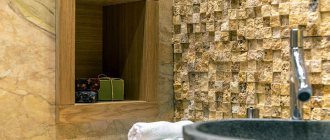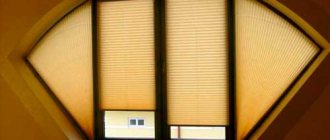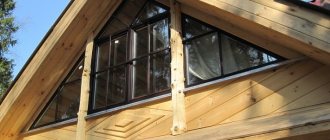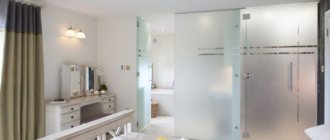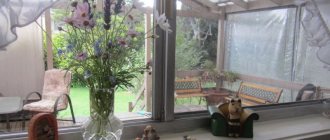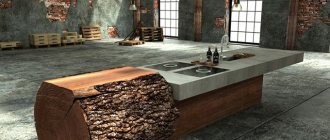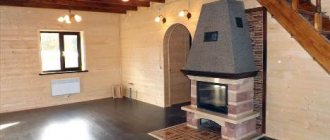Another tool in the architect's arsenal is scale and proportions. They refer to how the individual parts of the building relate to each other and how the overall unusual house harmonizes with the surrounding landscape.
Please note that scale does not necessarily mean size. Apartments can be quite large, but have a comfortable and intimate environment for a person. And vice versa. You can live quite beautifully in a small house using small elements and other design features.
Some designers and architects intuitively design buildings with great proportions, others use systems such as the golden ratio. Today we'll show you how to use these tools to design your own creative masterpiece.
Use the proportional system to set optimal room sizes
Determine the height and width of the room using the golden ratio - a technique that was developed a thousand years ago.
Sketch by Bud Dietrich, AIA
In this room, the height of the ceiling and the location of decorative panels on the brickwork of the wall were determined by a specialist based on measuring rules.
Bedroom by Bud Dietrich, AIA
Golden ratio in architecture
Many of the buildings that have survived to this day indicate that the architects of the Middle Ages knew about the existence of the golden ratio, and, of course, when building a house, they were guided by their primitive calculations and dependencies, with the help of which they tried to achieve maximum strength. The desire to build the most beautiful and harmonious houses was especially evident in the buildings of residences of reigning persons, churches, town halls and buildings of special social significance in society. For example, the famous Notre Dame Cathedral in Paris has many sections and dimensional chains in its proportions that correspond to the golden ratio.
Even before the publication of his research in 1855 by Professor Zeising, at the end of the 18th century the famous architectural complexes of the Golitsyn Hospital and the Senate building in St. Petersburg, the Pashkov House and the Petrovsky Palace in Moscow were built using the proportions of the golden section.
Of course, houses have been built in strict compliance with the golden ratio rule before. It is worth mentioning the ancient architectural monument of the Church of the Intercession on the Nerl, shown in the diagram. All of them are united not only by a harmonious combination of forms and high quality construction, but also, first of all, by the presence of the golden ratio in the proportions of the building. The amazing beauty of the building becomes even more mysterious if we take into account its age. The building of the Church of the Intercession dates back to the 13th century, but the building received its modern architectural appearance at the turn of the 17th century as a result of restoration and reconstruction.
Golden proportions of your home
Golden proportions of your home Creating a truly harmonious space is impossible without a clear understanding of the principles of creating and arranging your home. Over the course of thousands of years, our ancestors accumulated experience in building both individual houses and entire settlements. In this article I want to tell you about the “golden ratio”. About what even in scientific circles is usually called the “trademark of God” - the proportions according to which everything living and nonliving in the Universe is created: from the curls of a mollusk shell to the spiral eddies of galaxies, as well as man himself.
Man is an example of the “golden proportion”
Man is the measure of all things. Our ancestors understood this very well. That is why the original Slavic measuring system was based on the sizes of parts of the human body, as even the names themselves indicate - fathom oblique, flywheel, elbow, foot, span, metacarpus, etc. Accordingly, length measures already contained “golden proportions,” just as the human body itself embodies many relationships between its different parts. That is why buildings erected according to ancient Russian measures of length were examples of harmony and consistency with the surrounding nature!
] Of course, in everyday construction, Slavic craftsmen hardly resorted to special precise adjustment of their calculations to the golden number 0.618, and the observance of proportions arose due to developed intuition and the use of a unique system of units of measurement in Rus'.
Properties of Old Russian "sazhen"
So, in the ancient Russian numerical system of architectural planning, a set of tools under the general name “sazhen” was used as units of measurement. A significant feature of the ancient Russian measuring system is that there were dozens, or even hundreds of species of fathoms in Rus'. Moreover, each area could have its own fathoms - Chernigov, Moscow, Vladimir, Novgorod... (this could be due to the different heights of people from different regions and differences in the proportions of their bodies, because, for example, a northern person is different from a southern one). And any knowledgeable master could invent more than one personal fathom. And this is not surprising, because the house should be built for the owner. It doesn’t occur to us to wear rectangular boxes as clothes. We select clothes, as they say, “so that the suit fits” - according to your height, size and body proportions. It's the same with the house. A short man is uncomfortable in a giant's house. Just like a hero, there is no need to fight against low ceiling beams in a house with two-meter ceilings. As they say, everything ingenious is simple.
However, that's not all. As studies show, Old Russian fathoms, among other things, can hardly be called proportionate to each other. That is why modern researchers believe that the metric system, built on the use of a standard meter, is more perfect and convenient for use in calculations than a system built on the variety of fathoms disproportionate to each other.
A natural question arises: what is the reason for the centuries-old practice of our Ancestors using irrational tools of commensuration? Science is unlikely to give us an answer, and in the statements of scientists we see a one-sided, limited material perception of reality and, often, an inability to penetrate into the essence of phenomena, to comprehend their deep meaning and purpose.
The nature around us lives, pulsates, breathes. The smallest cells, organisms, plants, animals, as well as stones, planets, stars, in general, everything living and nonliving on Earth and in Space, pulsate. Everything moves, spreading vibrations in the form of a wide variety of waves. In the same way, parts of buildings: walls, ceilings, create certain vibrations already in the room itself. These vibrations are almost not picked up by devices (more precisely, devices that pick them up have not yet been created, since the phenomenon itself is not allowed), but they are very well felt by the human body. It is noted that in all rooms built on the basis of the metric system, there are standing waves that negatively affect the body of the people living in them [Chernyaev A.F., “Gold of Ancient Rus'”].
Moreover, these waves affect the human body, suppressing it and forcing it to spend its energy on resisting the wave effects, weakening it and promoting diseases. And the more standing waves there are in a living room, the more energy the body needs to spend to extinguish them. The secret of creating a harmonious Ancestral Home
Old Russian fathoms are not rational instruments in numerical terms, and therefore do not have a divisor that is multiple to themselves or to their parts. The lack of distance multiplicity leads to an imbalance of standing waves, and the proportionality of the proportions to the human body leads to the appearance of waves that resonate with the vibrations of the human body located in it. Such a room becomes the best place for people to live. Our Ancestors built exactly these kind of houses, which do not have a multiple of any measuring device, neither in length, nor in width, nor in height. And, apparently, it is for this reason that in ancient houses and churches people feel comfortable, calm, blessed and relaxed, although they do not understand what is behind it.
It must be admitted that although the meter is a brilliant invention, it is only suitable for measuring proportions that have already been found, and it is undesirable to plan and build on its basis.
When building your Ancestral House, it is necessary to take into account the experience and knowledge of our Ancestors. Improving existing homes can be done by visually dividing the room into parts corresponding to the golden proportion.
Putting these principles into practice will help revitalize any space, reduce the formation of unfavorable forces, and will also contribute to a more pleasant and orderly appearance of your home.
Rodogor and Svetoyara Kachurenko vk.com/slavyanskie_uzori">
Correct house architecture
A house with a successful architectural design will look good even without additional eye-catching details. But the lack of clear proportions is unsightly, even if the house is decorated with many spectacular elements. When designing a new house, we strive to ensure that its architectural solution is balanced. If it is organized and well proportioned, the house has a chance of looking good. Even if its finishing is not the best, repairs can always put the house in order.
Low-placed windows and eaves overhangs, which you can practically reach, create an atmosphere of close connection between the house and the garden.
Proportions (the ratio of the height of the walls and the size of the roof, the ratio of the sizes of various elements, etc.) play a major role in the architecture of the house. Naturally, there is no single principle, but some specific principle in the image of each house should be clearly visible. If a one-story house is low and horizontal, then the shape of its architectural details should correspond to its proportions. For example, horizontal windows, quite appropriate in this case, would look strange in a tall house.
The terrace adjacent to the dining room is shifted deeper into the house, forming a wide gallery. It is hidden from view and rather represents one of the many secluded corners in the garden
What is the “Golden Ratio”, how did it appear?
The golden ratio is the so-called “divine proportion”, visible in most natural objects: mollusk shells, tree leaves, honeycombs, the structure of flowers, spider webs, the human body, DNA molecules, bird eggs. It is also observed in the geometry of the Egyptian pyramids, many ancient sculptures, and paintings by famous artists.
The very essence of the “golden proportion” is the division of the whole into two unequal parts. The ratio of the smaller part to the larger, and the larger to the whole, looks like 0.618 to 1.0. Monk Luca Pacioli explained this as a “divine trinity”: the smaller part of the whole is the Son of God, the larger part is God the Father, and the whole is the Holy Spirit. It is not known for certain who first began to use it, but Leonardo da Vinci described it as accurately as possible. There is an assumption that good artists, musicians, architects, and other people of art use the golden ratio intuitively - because it turns out more beautiful.
A special case of “divine proportion” is the rule of thirds. It is determined by a person’s visual perception - when looking at a picture, the eye “clings” primarily to the main four points located at the intersection of vertical lines with horizontal ones, provided that the picture is divided into nine identical fragments. It is within these points that the main accents of the picture, its plot center, are placed.
Golden Ratio Spiral
The “divine proportions” also include the so-called Fibonacci series or Fibonacci spiral. A medieval mathematician compiled a sequence of numbers as follows: 1, 1, 2, 3, 5, 8, 13, 21, 34, 55, 89, 144, 233, 377, 610, 987, 1597, 2584, 4181, 6765, 10946 etc., where the sum of every two numbers that follow each other, starting with the second, is equal to the third. A striking example of the Fibonacci sequence is the phalanges of the human fingers, the ratio of the first to the second and third. Fibonacci spirals are visible when looking from above at a sunflower flower, pineapple, or cones. The shells of most mollusks and the horns of mountain goats also correspond to them.


